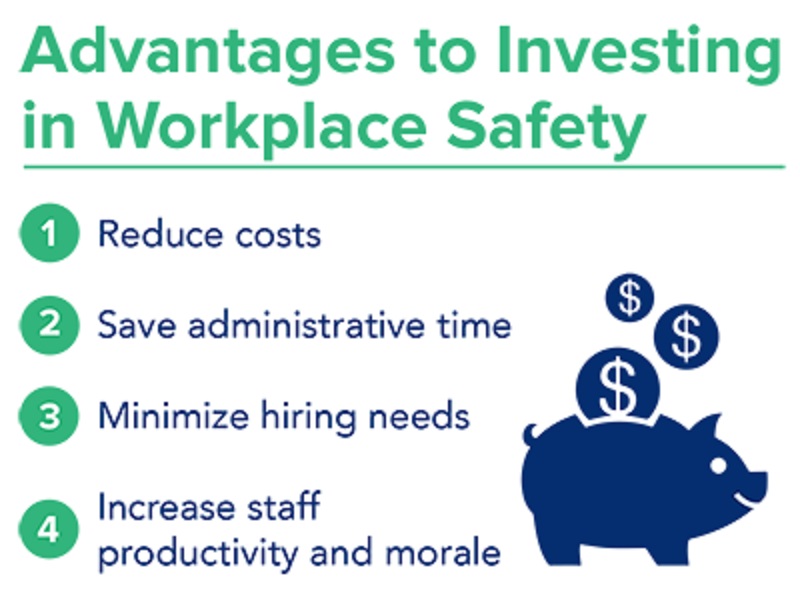
Articles
How Can Employers Benefit from Improved Workplace Safety Policies?

Occupational safety is a critical issue that employers should take seriously. While accidents and injuries can happen at any time, implementing safety policies and procedures is key to reducing the risk of harm. But beyond compliance with regulations, how can employers benefit from improved workplace safety policies?
In this blog post, we'll explore how establishing a culture of safety along with effective policy implementation could lead to tangible benefits for businesses large and small. We'll discuss what's involved in creating such an environment as well as why it pays off to invest resources into these initiatives.
So if you're wondering how can employers benefit from improved workplace safety policies, read on!
What is Workplace Safety?
Workplace safety is the practice of taking precautions to protect employees, equipment, and business property from potential workplace hazards. It is the moral responsibility of employers to ensure that their work environment is safe for all employees.
There are several regulations set by regulatory bodies such as OSHA which help employers with establishing safety practices and protocols in their organization. These regulations cover areas such as personal protective equipment (PPE), fire prevention, hazardous materials handling, and ergonomics.
Employers must provide training on safe work practices such as handling tools, machinery, and hazardous materials. They should also have emergency plans in place so that everyone knows what to do if an accident or injury occurs at work.
Part of a workplace safety program is conducting regular inspections onsite to identify workplace safety hazards before they become serious problems.
It’s important for employers to recognize that workplace safety isn’t just about preventing accidents — it can also improve morale among employees who feel safer when working in a safer workplace. Employers should make sure that workers know their rights regarding health and safety issues so they can report any concerns without fear of retribution or dismissal from their job.
So how can employers benefit from improved workplace safety policies, business-wise?
How Can Employers Benefit from Improved Workplace Safety Policies?
The benefits of improved workplace safety policies are numerous and should not be overlooked. Investing in a safe working environment can lead to increased productivity and efficiency, reduced risk of injury or illness, and improved employee morale and retention.
Not only does a safer workplace benefit the employees, but also the employers and the entire company as a whole.
Here are some of the main benefits that come with having workplace safety programs.
Increased Productivity
In a safe workplace, employees are able to focus better instead of worrying about what could go wrong. This leads to higher levels of productivity which translates into greater efficiency for the business overall.
Reduced Costs
Fewer sick days due to safety practices means less money spent on medical bills and insurance premiums. Additionally, fewer workplace accidents can help reduce costs associated with liability claims or lawsuits.
Taking steps towards creating a safe working environment reduces the likelihood that an employee will suffer from an injury or illness related to their job duties. By identifying potential workplace hazards ahead of time, employers can take action before any accidents occur which helps protect both employees and businesses from costly medical bills or legal issues.
Improved Morale
When workers feel secure in their environment, they are more likely to be motivated and productive at work which leads to higher morale among staff members.
Social Responsibility
With dedicated programs that promote safety, you are demonstrating that you are a socially responsible business — which adds significant value to your brand’s image.
Enhanced Reputation
By taking steps towards creating a safer working environment, you will gain respect from customers, suppliers, and investors, making them more likely to do business with you again.
Higher Employee Retention
Employees who feel safe at work are less likely to leave for another job opportunity so investing in workplace safety could help retain valuable talent within your organization for longer periods of time.

Establishing a Safety Culture
The first step in establishing a safety culture is to assess your current work environment and identify areas where you can improve safe work practices. Consider factors such as hazardous materials, equipment use, and any other potential risks that could lead to injury or illness.
After defining your safety goals, it’s time to develop an actionable plan for achieving them. This should include details about who will be responsible for carrying out each task and what resources are needed.
Make sure there are systems in place for monitoring progress toward meeting your safety objectives. This could involve regular inspections of the workplace or tracking employee compliance with the company’s safety program.
Finally, ensure there is someone available at all times who can answer questions about these topics if needed.
Implementing Workplace Safety Policies
Employers have a responsibility to ensure the safety of their employees while on the job. A company’s safety program is key to creating a safe work environment and protecting workers from harm.
Identify Potential Workplace Safety Hazards
The first step in establishing workplace safety programs is identifying potential hazards that could cause injury or illness. This includes assessing the following:
- Physical risks such as slippery floors, sharp edges, or hazardous materials.
- Environmental risks such as extreme temperatures or poor ventilation.
- Psychological risks such as stress or fatigue.
Employers should also consider any unique hazards specific to their industry like heavy machinery in manufacturing plants or dangerous chemicals in laboratories.
Create an Emergency Response Plan
Once potential hazards have been identified, employers need to create an emergency response plan outlining how they will respond if an accident occurs on the job site. This plan should include steps for evacuating the premises quickly and safely, providing medical attention for injured workers, notifying authorities when necessary, and documenting all incidents thoroughly for future reference.
Establish Reporting Protocol
Finally, employers must establish reporting procedures so that employees can report unsafe conditions without fear of retaliation from management or coworkers. This could involve setting up anonymous tip lines, conducting regular surveys, and ensuring there are clear channels of communication between managers and staff members.
Ensuring Compliance with Regulations
Employers must stay up-to-date with local and federal laws regarding workplace safety in order to remain compliant.
Managers should also provide safety training sessions and keep track of any inspections or audits conducted by regulatory agencies so you can refer back to them if needed.
Finally, employers need to take corrective action when necessary in order to maintain compliance with workplace safety regulations. If an inspection reveals a violation or potential hazard, employers should take steps immediately to address the issue before it becomes more serious. This could include additional safety training, implementing new policies or procedures, and ensuring that all employees are aware of any changes to safety protocols.
Conclusion
How can employers benefit from improved workplace safety policies? Not only do these policies promote safety but they also provide businesses with peace of mind knowing that they are protecting employees from harm while at work.
On the business side, workplace safety policies help reduce costs associated with accidents or injuries and protect employers from costly litigation.
With all this in mind, it’s easy to see why so many employers are taking steps toward improving their workplace safety policies — after all, who wouldn’t want a safer working environment?
Trainual is here to help businesses of all sizes create comprehensive procedures for protecting their people and property — so don’t wait any longer: get started now with building your workplace safety policy!
Similar Blog Posts







